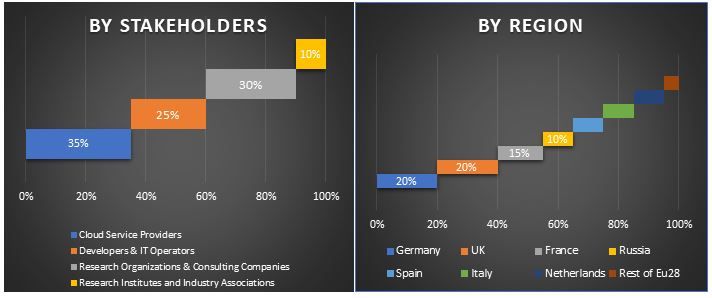- Home
- About Us
- Industry
- Services
- Reading
- Contact Us
Europe Digital Transformation Market: Current Analysis and Forecast (2021-2027)
Emphasis on Component [Solutions (Cloud Computing, Big Data & Analytics, Mobility, Disruptive Technology, Social Media); Services (Professional Services, System Integration)]; by Deployment Type (On-Premises, Cloud); by End-User (Large Enterprises, Small and Medium Enterprises); Industry Verticals (BFSI, Government, Healthcare, Telecom & IT, Automotive, Retail & Consumer Goods, Media & Entertainment, Manufacturing, Other industry) and Country

Digital technologies are dramatically reshaping every industry, several companies are doing large-scale change efforts to capture the benefits of the ongoing digital transformation trend or simply to keep up with their competitors. The results of digital transformation may take time but not opting for transformation is not an option for one to survive in the competitive world. For instance, on average, European firms are less often fully digital, and are particularly lacking in the construction sector, dragging down the digital intensity score. Furthermore, US firms invest more in business process improvements compared to the European counterparts. However, firms in the European region and the US perceive digital infrastructure similarly. As per a study conducted by one of the top consulting firm, European companies lags US companies in terms of R&D investment and adoption of digital technologies. Using firm-level data from 2019, it is stated that larger firms have higher rates of digital adoption, compared to their smaller peers, and that digital firms have better management practices and show more dynamism. Only 66% of manufacturing firms in the Europe have adopted at least one digital technology, compared to 78% in the US. The difference is particularly large in the construction sector, where the share of digital firms in Europe stands at 40%, compared to 61% in the US. In the service sector the difference between Europe and US is 13% and 11% in the infrastructure sector.
Adoption of Digital Technology among European Industries (% of total firms), 2019
Insights Presented in the Report
“Amongst component, Solution segment holds the major share.”
Based on the component, the European digital transformation market is bifurcated into Solutions and Services. The solution sub-segment is further divided into cloud computing, big data and analytics, mobility, disruptive technology, and social media. Moreover, Service segment is divided into professional services and system integration. Service segment generated revenue of US$ 66.1 billion in 2020. Solution segment is expected to witness CAGR growth of 15.16% during the forecast period.
“Amongst deployment type, cloud dominated the market in 2020.”
Based on Deployment type the market is segmented into On-premises and cloud deployment. Currently, cloud deployment model dominated the market and is expected to maintain its dominance during the analyzed period. On-Premise’s segment is expected to witness CAGR growth of 13.83% during the forecast period.
“Amongst End-user, large enterprises are expected to dominate the market during the analyzed period.”
Based on end-user the European digital transformation market is bifurcated into large enterprises and SME’s. Owing to high cost of digital technology deployment large enterprise invested most on digital technology. The segment generated revenue of US$ 203.8 billion in 2020.
“Amongst industry verticals, Banking Financial Services & Insurance dominated the market in 2020.”
Based on industry vertical, the market is fragmented into BFSI, healthcare, telecom & IT, automotive, education, retail & consumer goods, media & entertainment, manufacturing, government, and others. Healthcare segment is expected to witness highest CAGR growth of 18.95% during the analyzed period.
“Germany represents as the largest markets in the Europe Digital Transformation market.”
For better understanding of the market penetration of digital transformation, the report provides detailed analysis of major countries including Europe (Germany, UK, Russia, France, Spain, Italy, Rest of Europe). Germany dominated the % share in 2020. However, Spain is expected to witness highest CAGR growth of 19.76% during the forecast period. Some of the major players operating in the market include IBM Corporation, Cognizant, SAP SE, Dell, Microsoft Corporation, Adobe Systems Incorporated, Accenture PLC, Capgemini, Oracle Corporation and Google Inc.
Reasons to buy this report:
- The study includes market sizing and forecasting analysis validated by authenticated key industry experts
- The report presents a quick review of overall industry performance at one glance
- The report covers in-depth analysis of prominent industry peers with a primary focus on key business financials, product portfolio, expansion strategies, and recent developments
- Detailed examination of drivers, restraints, key trends, and opportunities prevailing in the industry
- The study comprehensively covers the market across different segments
- Deep dive country level analysis of the industry
Customization Options:
The European Digital Transformation Market can further be customized as per the requirement or any other market segment. Besides this, UMI understands that you may have your own business needs, hence feel free to connect with us to get a report that completely suits your requirements.
Table of Content
Analyzing the historical market, estimation of the current market, and forecasting the future of the Europe Digital Transformation Market were the three major steps undertaken to create and analyze the adoption of Digital Transformation across various industry verticals in major European countries. Exhaustive secondary research was conducted to collect the historical market numbers and estimate the current market size. Secondly, to validate these insights, numerous findings and assumptions were taken into consideration. Moreover, exhaustive primary interviews were also conducted, with industry experts across the value chain of the digital transformation sector. Post assumption and validation of market numbers through primary interviews, we employed a bottom-up approach to forecast the complete market size. Thereafter, market breakdown and data triangulation methods were adopted to estimate and analyze the market size of segments and sub-segments the industry pertains to. Detailed methodology is explained below:
Analysis of Historical Market Size
Step 1: In-Depth Study of Secondary Sources:
Detail secondary study was conducted to obtain the historical market size of the Digital Transformation through company internal sources such as annual report & financial statements, performance presentations, press releases, etc., and external sources including journals, news & articles, government publications, competitor publications, sector reports, third-party database, and other credible publications.
Step 2: Market Segmentation:
After obtaining the historical market size of the Digital Transformation market, we conducted a detailed secondary analysis to gather historical market insights and share for different segments & sub-segments for major regions. Major segments included in the report as component, deployment type, end-user, and industry verticals. Further country-level analyses were conducted to evaluate the overall adoption of the Digital Transformation in the European region.
Step 3: Factor Analysis:
After acquiring the historical market size of different segments and sub-segments, we conducted a detailed factor analysis to estimate the current market size of Digital Transformation. Further, we conducted factor analysis using dependent and independent variables such as growth of penetration of digital transformation across different industry, digitalizing business functions and Unfavorable firm-size distribution. A thorough analysis was conducted for demand and supply-side scenario considering top partnerships, merger and acquisition, business expansion, and product launches in the Digital Transformation industry.
Current Market Size Estimate & Forecast
Current Market Sizing: Based on actionable insights from the above 3 steps, we arrived at the current market size, key players in the European Digital Transformation market, and market shares of the segments. All the required percentage shares split, and market breakdowns were determined using the above-mentioned secondary approach and were verified through primary interviews.
Estimation & Forecasting: For market estimation and forecast, weights were assigned to different factors including drivers & trends, restraints, and opportunities available for the stakeholders. After analyzing these factors, relevant forecasting techniques i.e., bottom-up approach was applied to arrive at the market forecast to 2027 for different segments and subsegments across the major countries in the European region. The research methodology adopted to estimate the market size encompasses:
- The industry’s market size, in terms of value (US$) and the adoption rate of Digital Transformation across the major markets
- All percentage shares, splits, and breakdowns of market segments and sub-segments
- Key players in the Digital Transformation market in terms of services offered. Also, the growth strategies adopted by these players to compete in the fast-growing market.
Market Size and Share Validation
Primary Research: In-depth interviews were conducted with the Key Opinion Leaders (KOLs) including Top Level Executives (CXO/VPs, Sales Head, Marketing Head, Operational Head, and Regional Head, Country Head, etc.) across major countries. Primary research findings were then summarized, and statistical analysis was performed to prove the stated hypothesis. Inputs from primary research were consolidated with secondary findings, hence turning information into actionable insights.
Split of Primary Participants in Different Regions
Market Engineering
Data triangulation technique was employed to complete the overall market estimation and to arrive at precise statistical numbers of each segment and sub-segment of the European Digital Transformation market. Data was split into several segments & sub-segments post studying various parameters and trends in the areas of component, deployment type, end-user, and industry verticals.
The main objective of the Digital Transformation Market Study
The current & future market trends of Digital Transformation were pinpointed in the study. Investors can gain strategic insights to base their discretion for investments from the qualitative and quantitative analysis performed in the study. Current and future market trends were determined the overall attractiveness of the market at a country level, providing a platform for the industrial participant to exploit the untapped market to benefit as a first-mover advantage. Other quantitative goals of the studies include:
- Analyze the current and forecast market size of Digital Transformation in terms of value (US$). Also, analyze the current and forecast market size of different segments and sub-segments
- Segments in the study include areas of component, deployment type, end-user, and industry verticals
- Defined analysis of the regulatory framework for the Digital Transformation industry
- Analyze the value chain involved with the presence of various intermediaries, along with analyzing customer and competitor behaviors of the industry
- Analyze the current and forecast market size of the Digital Transformation for the major countries
- Major countries studied in the report include Europe (Germany, UK, Russia, France, Italy, Spain, Rest of Euro)
- Company profiles of the Digital Transformation market players and the growth strategies adopted by them to sustain in the fast-growing market
- Deep dive country level analysis of the industry
Related Reports
Customers who bought this item also bought












